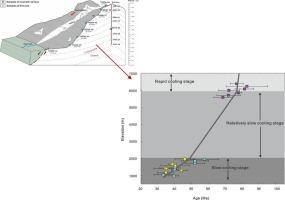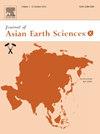Cenozoic exhumation of the North Qinling Range: Insights from apatite and zircon (U-Th)/He thermochronology
IF 2.3
Q3 GEOSCIENCES, MULTIDISCIPLINARY
引用次数: 0
Abstract
The Cenozoic uplift of the North Qinling Range has profoundly influenced climatic and ecological patterns across northern and southern China. However, key aspects of this orogenic event, including its principal phase(s) of exhumation, total magnitude, and detailed evolutionary processes remain poorly constrained. We present a series of apatite and zircon (U-Th)/He ages from a drill core and surface relief of Zhongnan Mt., in the middle part of North Qinling Range. Comparative analysis of apatite (U-Th)/He age discrepancies between drill core and surface samples provides a perspective to figure out variation of isotherms and then helps figure out that fault activity and topographic wave length were dominant controls on isotherm geometry in the study area. The composite vertical pseudo-transect constructed from apatite and zircon (U-Th)/He ages indicates a very fast cooling period since at least ∼ 82.7 Ma and lasted to 77 Ma, followed by a relatively slow cooling stage until 49 Ma, and then a slow cooling period to 33 Ma. These three exhumation stages are widely documented in the adjacent region, with the subduction of the Pacific Plate considered the primary driving mechanism.

北秦岭新生代发掘:磷灰石和锆石(U-Th)/He热年代学的启示
新生代北秦岭隆升深刻影响了中国南北的气候和生态格局。然而,这次造山事件的关键方面,包括它的主要掘出阶段、总规模和详细的演化过程,仍然知之甚少。本文从北秦岭中段终南山岩心和地表起伏中获得了一系列磷灰石和锆石(U-Th)/He年龄。对比分析岩心与地表样品的磷灰石(U-Th)/He年龄差异,为研究区等温线的变化提供了一个视角,从而有助于了解断层活动性和地形波长是研究区等温线几何形状的主要控制因素。由磷灰石和锆石(U-Th)/He年龄构成的复合垂直伪样带表明,该区至少从~ 82.7 Ma开始经历了一个非常快速的冷却期,并持续到77 Ma,随后是一个相对缓慢的冷却期,直到49 Ma,然后是一个缓慢冷却期,直到33 Ma。这三个掘出阶段在邻近地区有广泛的记载,太平洋板块的俯冲作用被认为是主要的驱动机制。
本文章由计算机程序翻译,如有差异,请以英文原文为准。
求助全文
约1分钟内获得全文
求助全文
来源期刊

Journal of Asian Earth Sciences: X
Earth and Planetary Sciences-Earth-Surface Processes
CiteScore
3.40
自引率
0.00%
发文量
53
审稿时长
28 weeks
 求助内容:
求助内容: 应助结果提醒方式:
应助结果提醒方式:


